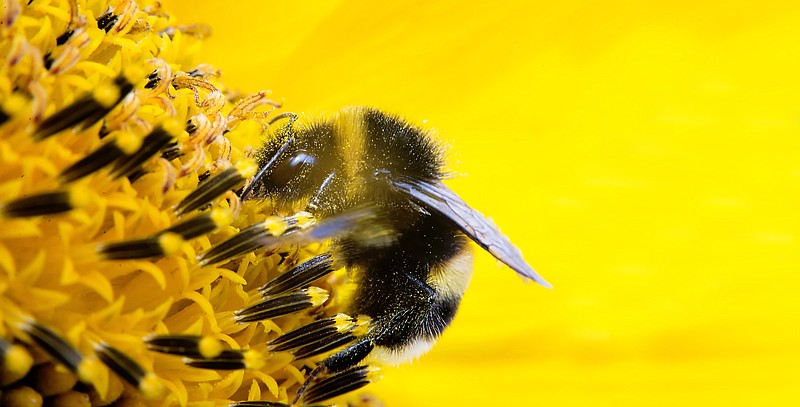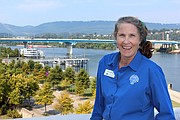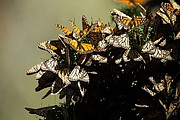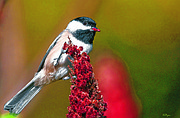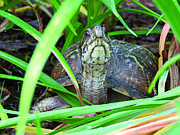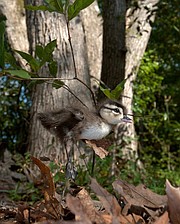Every morning, the bumblebees are first to arrive in Bill Haley's backyard. They flit about his zinnias, searching for the most delicious-smelling ones. There, they land and begin to gather food in their baskets, small sacs on their hind legs used to store pollen.
"I hate to play favorites, but the bumblebee is my favorite insect. They're the most hardworking - first to arrive in the morning and the last to leave in the evening," says Haley, education outreach coordinator for the Tennessee Aquarium. "Every one that you see is a female. They do all the work in the bumblebee society."
In 1986, Haley had his North Chattanooga backyard certified as a wildlife habitat by the National Wildlife Federation. The process involves providing various forms of food, water, shelter and places for animals to raise their young - nesting boxes or mature trees, for example - as well as maintaining sustainable practices, such as eliminating chemical pesticides and fertilizers.
Healthy habitats are now more critical than ever, Haley says. Amid the expansion of the suburban frontier, backyard wildlife like bumblebees, box turtles and some songbirds are being displaced at record rates. Over the past few decades, native bumblebee populations have declined more than 90 percent; the eastern box turtle by 30 percent; and 30 percent of North American songbirds are also in decline, according to the National Wildlife Federation.
These animals don't require vast plots of land to thrive, says Haley, whose own backyard is less than a quarter-acre. "People would probably be surprised how easy it is to fill all their needs. You grow flowers; you have a bird bath and brush pile; you quit spraying poison," he says.
Just beyond Chattanoogans' backdoors, there are many fascinating species worthy of protection. Here, experts from the Tennessee Aquarium weigh in on why we should care and how we can help.
HOW TO HELP
A healthy backyard ecosystem, Brock says, should feature native plants that vary in height and season. For example, creeping phlox, a ground cover that blooms in early spring; wild hydrangea, which stand 3-6-feet tall and bloom in the summer; and sunflowers, which can grow up to 8 feet tall and blossom in early autumn. "'Native' is the keyword when you go to the nursery," Brock says. But, she adds, it's also crucial to ask for plants that are neonicotinoid-free. Neonicotinoid is an insecticide used to treat plants, killing any insect that tries to feed on its leaves, nectar or pollen. "It isn't good to put out a flower filled with poison. Let's learn to live alongside bugs. Let's learn to provide for them," Brock says. "Don't be afraid to be a little messy. Nature likes it that way.
Every native flower has a story, says Christine Brock, aquarium lead horticulturalist.
The blueberry blossom shares a special relationship with the southeastern blueberry bee, evolved over millennia to specialize in blueberry pollination. The wild violet acts as a nursery to the fritillary butterfly, being the only plant on which it will lay eggs. And goldenrod is one of nature's most misunderstood flowers.
"People think goldenrod gives them hay fever, but it doesn't," Brock says.
The mix-up occurs because goldenrod blooms at the same time as ragweed, known to cause nasal allergies. While ragweed relies on airborne pollination, casting millions of tiny pollen particles into the wind, goldenrod is pollinated by insects. This means its pollen is much heavier, and less likely to float through the air, Brock explains.
With its sunny clusters of flowers, goldenrod can be a dazzling and valuable addition to one's garden, and its nectar is an important food source for flies, bees and butterflies.
When planting, "native" is an important word, Brock says. While non-native plants like box honeysuckle and Japanese dogwood add color and fragrance, "when you have plants that don't come from Georgia or Tennessee, your yard is a biological desert," she says.
HOW TO HELP
Host plants are a must, Taylor says. But there are more ways to attract butterflies. In addition to planting a butterfly's favorite flower, Taylor recommends setting out a mixture of rotting fruit - bananas, melons, even stale beer. Many butterflies enjoy drinking the juices. To avoid attracting unwanted wildlife, she suggests bringing in the "brew" and freezing it overnight. She also recommends setting out a shallow tray of water mixed with sand. "Have you ever noticed butterflies gathering at a mud puddle?" Taylor asks. "Mostly the males do this to get extra minerals they may need for reproduction. It's a behavior called 'puddling.'"
The monarch migration from Mexico to Canada is an awesome phenomenon. Every winter, the butterflies migrate by the millions south to Mexico, where they hibernate in the same trees year after year. Come spring, they head north, stopping in places such as Texas. There, the monarchs mate, lay eggs and die. The larvae then hatch, form a chrysalis, transform into a butterfly and complete the migration to Canada.
"They arrive in Chattanooga twice a year, first around March and again around August, depending on weather," says Jennifer Taylor, aquarium entomologist. These spring and late-summer sightings represent two different generations, she explains.
In recent years, these sightings are becoming fewer - linked, largely, to the decline of milkweed, the monarch's host plant.
All butterfly species have a host plant, which is the only plant on which it will lay eggs and its larvae will feed. For the zebra swallowtail, it's pawpaw; for the Edwards' fritillary, it's violets; and for the monarch, of course, it is milkweed.
Once abundant across farmlands, milkweed has been devastated by pesticides. Over the past 20 years, it has been reduced by 21 percent. In that same time, monarch populations have declined by 90 percent, the National Wildlife Federation reports.
"Butterflies are so visible," Taylor says. Their presence represents a healthy environment, from the backyard and beyond.
HOW TO HELP
Food is important, but water is doubly so, Calhoon says. This is especially true during summer heat and winter freezes. Calhoon suggests adding a pond, a bird bath or, during warmer months, a water sprinkler. The sound of moving water helps attract birds, says Calhoon, who fixed his bird bath with a metal dripper. Water sources should additionally have a shallow section. "An 8-inch-deep pond is great for a crow, but a little chickadee needs something half-inch deep," he says. Moreover, he cautions against the use of insecticides, which poison birds' food source. A healthy ecosystem will care for itself. Bluebirds and purple martins will control insect populations. Insects will help pollinate wildflowers. And wildflowers, as horticulturalist Christine Brock says, "is the earth's way of saying hello, slow down, take a look."
Birds that frequent a feeder do more than add backyard color. They paint a picture, illustrating events happening elsewhere in the world, says Kevin Calhoon, aquarium curator of forests.
Take the purple finch, for example (which is actually red and brown). Some winters, it arrives to Tennessee in flocks. Other winters, it doesn't come at all. The reason for this behavior, described by birders as "irruptive," is food availability, Calhoon explains. A seed-eater, the purple finch relies heavily on pine cones. A cone crop could fail due to a number of reasons: drought, late frost, insect outbreak.
When the purple finch arrives en masse to Tennessee, one of these factors is likely at play up north, causing the bird, which migrates from Canada, to travel farther south to find food.
"One of the things I like about small birds is the travels they take," Calhoon says.
Songbirds, he continues, are the most accessible wildlife to watch. If a person has a bird-friendly backyard, every spring, he or she also has a front row seat to spectacular species only present for a few weeks.
"You don't have to actively pursue them," Calhoon says. "When you walk the dog, when you go out to the mailbox, when you're doing the dishes and you look out your kitchen window, be aware of what's there."
HOW TO HELP
There are three big ways to manage one's backyard for the box turtle. First, create edges, adding strips of grass between flower beds, for example. This allows the cold-blooded turtle and other small wildlife to easily move from sun to shade. Second, create corridors, or areas that allow animals to safely move from one part of the yard to another. "Instead of making a garden an island, make it a peninsula," Collins says. Third, create layers - leaf litter, fallen branches and low shrubs, for example. "A brush pile is like a Hilton Hotel to small animals," Collins says. "You don't need to manage every square inch of your yard." Moreover, he says, be aware that turtles are most active in the morning. "The lawnmower is an incredibly dangerous machine to little animals that live on the ground," Collins says. When it comes to protecting the slow-moving turtles, the safest time to mow is in the afternoon.
"I have a strong bias for turtles," says Dave Collins, director of forests and animal behavior at the Tennessee Aquarium. "I find them to be living sculptures. They are ornate and durable. It fascinates me how they hatch an inch in size, establish themselves and then live to become as old as I am."
In fact, box turtles can live to be 100 years old. As adults, they expand their permanent home range to encompass about 3-5 acres.
"They get to know that place really well - the berry patch, the brush pile," Collins says. Turtles have an incredible homing instinct. So when suburban development pushes the box turtle beyond its rooted habitat, it will fight to find its way back home.
"When I walk into my backyard, look over and see a box turtle, I feel like we have this intimate relationship," Collins says. "Some of the these turtles I see, I first met 25 years ago."
Don't Miss This:
Through April, the Tennessee Aquarium will host a series showcasing the importance of backyard wildlife. The event kicks off March 16 with the launch of "The Wild Around You 3D" at the downtown IMAX theater. The film features awe-inspiring footage of all the hidden wonders of one family's backyard. For a full calendar listing of the related nature talks, walks and films, visit tnaqua.org/events-programs.
